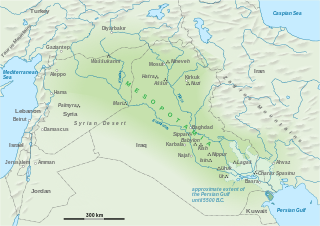Related Research Articles

The 7th century BC began the first day of 700 BC and ended the last day of 601 BC.

The 17th century BC was the century that lasted from 1700 BC to 1601 BC.
The 18th century BC was the century that lasted from 1800 BC to 1701 BC.
The 1690s BC was a decade lasting from January 1, 1699, BC to December 31, 1690, BC.

Babylonia was an ancient Akkadian-speaking state and cultural area based in the city of Babylon in central-southern Mesopotamia. It emerged as an Amorite-ruled state c. 1894 BC. During the reign of Hammurabi and afterwards, Babylonia was called "the country of Akkad", a deliberate archaism in reference to the previous glory of the Akkadian Empire. It was often involved in rivalry with the older ethno-linguistically related state of Assyria in the north of Mesopotamia and Elam to the east in Ancient Iran. Babylonia briefly became the major power in the region after Hammurabi created a short-lived empire, succeeding the earlier Akkadian Empire, Third Dynasty of Ur, and Old Assyrian Empire. The Babylonian Empire rapidly fell apart after the death of Hammurabi and reverted to a small kingdom centered around the city of Babylon.

The 1790s BC was a decade lasting from January 1, 1799 BC to December 31, 1790 BC. During this decade, the Near East was in the midst of the Middle Bronze Age.

The Thirteenth Dynasty of ancient Egypt is often combined with Dynasties XI, XII and XIV under the group title Middle Kingdom. Some writers separate it from these dynasties and join it to Dynasties XIV through XVII as part of the Second Intermediate Period. Dynasty XIII lasted from approximately 1803 BC until approximately 1649 BC, i.e. for 154 years.

Apepi, Apophis ; regnal names Neb-khepesh-Re, A-qenen-Re and A-user-Re) was a Hyksos ruler of Lower Egypt during the Fifteenth Dynasty and the end of the Second Intermediate Period. According to the Turin Canon of Kings, he reigned over the northern portion of Egypt for forty years during the early half of the 16th century BCE. Although officially only in control of the Lower Kingdom, Apepi in practice dominated the majority of Egypt during the early portion of his reign. He outlived his southern rival, Kamose, but not Ahmose I.

The history of Mesopotamia ranges from the earliest human occupation in the Paleolithic period up to Late antiquity. This history is pieced together from evidence retrieved from archaeological excavations and, after the introduction of writing in the late 4th millennium BC, an increasing amount of historical sources. While in the Paleolithic and early Neolithic periods only parts of Upper Mesopotamia were occupied, the southern alluvium was settled during the late Neolithic period. Mesopotamia has been home to many of the oldest major civilizations, entering history from the Early Bronze Age, for which reason it is often called a cradle of civilization.

Seuserenre Khyan (also Khayan or Khian was a Hyksos king of the Fifteenth Dynasty of Egypt, ruling over Lower Egypt in the second half of the 17th century BCE. His royal name Seuserenre translates as "The one whom Re has caused to be strong." Khyan bears the titles of an Egyptian king, but also the title ruler of the foreign land. The later title is the typical designation of the Hyksos rulers.

Maaibre Sheshi was a ruler of areas of Egypt during the Second Intermediate Period. The dynasty, chronological position, duration and extent of his reign are uncertain and subject to ongoing debate. The difficulty of identification is mirrored by problems in determining events from the end of the Middle Kingdom to the arrival of the Hyksos in Egypt. Nonetheless, Sheshi is, in terms of the number of artifacts attributed to him, the best-attested king of the period spanning the end of the Middle Kingdom and the Second Intermediate period; roughly from c. 1800 BC until 1550 BC. Hundreds of scaraboid seals bearing his name have been found throughout Canaan, Egypt, Nubia, and as far away as Carthage, where some were still in use 1,500 years after his death.

The chronology of the ancient Near East is a framework of dates for various events, rulers and dynasties. Historical inscriptions and texts customarily record events in terms of a succession of officials or rulers: "in the year X of king Y". Comparing many records pieces together a relative chronology relating dates in cities over a wide area.

The timeline of ancient Assyria can be broken down into three main eras: the Old Assyrian period, Middle Assyrian Empire, and Neo-Assyrian Empire. Modern scholars typically also recognize an Early period preceding the Old Assyrian period and a post-imperial period succeeding the Neo-Assyrian period.

The Middle Babylonian period, also known as the Kassite period, in southern Mesopotamia is dated from c. 1595 – c. 1155 BC and began after the Hittites sacked the city of Babylon. The Kassites, whose dynasty is synonymous with the period, eventually assumed political control over the region and consolidated their power by subjugating the Sealand dynasty c. 1475 BC. After the subjugation of the Sealand dynasty, the Kassites unified the region of Babylonia into a single political entity. At the height of the Middle Babylonian period, the Kassite kings were engaging in commerce, trade, and organising diplomatic marriages with the kings of Egypt and other regional powers. However, after a period of gradual decline, the Middle Babylonian period collapsed with the fall of the Kassite dynasty c. 1155 BC. The collapse came as a result of an Assyrian invasion, that temporarily displaced the Kassites from their rule over southern Mesopotamia. Finally, the Elamites conducted various raids and eventually invaded Babylonian c. 1158 BC, which brought the Kassite dynasty and Middle Babylonian period to an end.
References
- ↑ "Joseph, Egypt and the Hyksos..." The Freeman Institute Foundation.